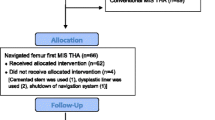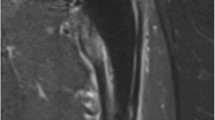Abstract
Purpose
To analyse the influence of femoral stem design in the lateral plane (anatomic vs. straight) on the cement mantle quality.
Method
In this consecutive multi-surgeon radiographic study we determined, Dorr grading, cement mantle quality (Barrack) and mantle thickness using Gruen zones 1–14 in 280 primary cemented total hip replacements, divided into two groups (140 anatomic Biomet Olympia, 140 straight Exeter Universal Series).
Results
Twenty-three per cent of the straight Exeter Universal stems had a cement mantle of <2 mm thickness in Gruen zone 8 and 25% in Gruen zone 9, compared to 0.7% of the anatomical Olympia stems in Gruen zone 8 and 1.4% in Gruen zone 9. The difference between the two groups was statistically significant (P < 0.001). In all other zones no significant differences were found.
Conclusion
This radiological study confirms that femoral stems with an anatomical curve in the lateral plane carry a lower risk of thin cement mantles (especially in Gruen zones 8 and 9) than straight stems. Cement mantle analysis in one radiographic plane only is insufficient.




Similar content being viewed by others
References
Aamodt A, Nordsletten L, Havelin LI, Indrekvam K, Utvag SE, Hviding K (2004) Documentation of hip prostheses used in Norway: a critical review of the literature from 1996–2000. Acta Orthop Scand 75(6):663–676
Anthony PP, Gie GA, Howie CR, Ling RSM (1990) Localised endosteal bone lysis in relation to the femoral components of cemented total hip arthroplasties. J Bone Joint Surg 72B:971–979
Barrack RL, Mulroy RD, Harris WH (1992) Improved cementing techniques and femoral component loosening in young patients with hip arthroplasty. A 12 year radiographic follow up. J Bone Joint Surg 74B:385–389
Bartlett GE, Beard DJ, Murray DW, Gill HS (2008) The femoral stem pump in cemented hip arthroplasty: an in vitro model. Med Eng Phys 30(8):1042–1048
Breusch SJ, Lukoschek M, Kreutzer J, Brocai DRC, Gruen T (2001) Dependency of cement mantle thickness on femoral stem design and centralizer. J Arthroplasty 16(5):648–657
Breusch SJ, Draenert Y, Draenert K (1998) Anatomic basis of the cemented femur shaft. A comparative study of straight and anatomic design. Z Orthop Ihre Grenzgeb 136:554–559
Britton AR, Murray DW, Bulstrode CJ, McPherson K, Denham RA (1996) Long-term comparison of Charnley and Stanmore design total hip replacements. J Bone Joint Surg 78B:802–808
Crawford RW, Psychoyios V, Gie G, Ling R, Murray D (1999) Incomplete cement mantles in the sagittal femoral plane: an anatomical explanation. Acta Orthop Scand 70(6):596–598
Cristofolini L, Erani P, Savigni P, Grupp T, Thies O, Viceconti M (2007) Increase long-term failure risk associated with excessively thin cement mantle in cemented hip arthroplasty: a comparative in vitro study. Clin Biomech 22(4):410–421 (Epub February 1, 2007)
Dorr LD (1985) Optimizing results of total joint arthroplasty. Instr Course Lect 34:401–404
Ebramzadeh E, Sarmiento A, McKellop HA, Llinas A, Gogan W (1994) The cement mantle in total hip arthroplasty. J Bone Joint Surg Am 76A:77–87
Estok DM, Orr TE, Harris WH (1997) Factors affecting cement strains near the tip of a cemented femoral component. J Arthroplasty 12(1):40–48
Garrelick G, Malchau H, Regner H, Herberts P (1999) The Charnley versus the Spectron hip prosthesis: radiographic evaluation of a randomized, prospective study of 2 different hip implants. J Arthroplasty 14(4):414–425
Gerritsma-Bleeker CL, Deutman R, Mulder TJ, Steinber JD (2000) The Stanmore total hip replacement. A 22-year follow-up. J Bone Joint Surg 82B(1):97–102
Gruen TA, McNeice GM, Amstutz HC (1979) Modes of failure of cemented stem-type femoral components. A radiographic analysis of loosening. Clin Orthop Relat Res 141:17–27
Harris WH (1995) The problem is osteolysis. Clin Orthop Relat Res 311:46–53
Huddleston HD (1988) Femoral lysis after cemented hip arthroplasty. J Arthroplasty 4:285–297
Huiskes R (1980) Some fundamental aspects of human joint replacement. Analyses of stresses and heat conduction in bone-prosthesis structures. Acta Orthop Scand 185(Suppl):109–200
Issack PS, Botero HG, Hiebert RN, Bong MR, Stuchin SA, Zuckerman JD, Di Cesare PE (2003) Sixteen-year follow-up of the cemented spectron femoral stem for hip arthroplasty. J Arthroplasty 18(7):925–930
Iwase T, Wingstrand I, Pesson BM, Kesteris U, Hasegawa Y, Wingstrand H (2002) The ScanHip total hip arthroplasty: radiographic assessment of 72 hips after 10 years. Acta Orthop Scand 73:54–59
Jasty MJ, Floyd WE, Schiller AL, Goldring SR, Harris WH (1986) Localized osteolysis in stable, non-septic total hip arthroplasty. J Bone Joint Surg 68A:912–919
Johnston RC, Fitzgerald RH, Harris WH, Poss R, Müller ME, Sledge CB (1990) Clinical and radiographic evaluation of total hip replacement. J Bone Joint Surg 72A:161–168
Johnston RC, Fitzgerald RH Jr, Harris WH, Poss R, Müller ME, Sledge CB (1990) Clinical and radiographic evaluation of total hip replacement. A standard system of terminology for reporting results. J Bone Joint Surg Am 72(2):161–168 (no abstract available); Erratum in J Bone Joint Surg Am 73(6):952 (1991)
Joshi AB, Porter ML, Trail IA et al (1993) Long-term results of Charnley low friction arthroplasty in young patients. J Bone Joint Surg 75B:616–623
Joshi RP, Eftekhar NS, McMahon DJ, Nercessian OA (1998) Osteolysis after Charnley primary low-friction arthroplasty. A comparison of two matched paired groups. J Bone Joint Surg 80B:585–590
Kawate K, Maloney WJ, Bragdon CR, Biggs SA, Jasty M, Harris WH (1998) Importance of a thin cement mantle. Autopsy studies of eight hips. Clin Orthop Relat Res 355:70–76
Kerboull L, Hamadouche M, Courpied JP, Kerboull M (2004) Long-term results of Charnley–Kerboull hip arthroplasty in patients younger than 50 years. Clin Orthop Relat Res 418:112–118
Kwak BM, Lim Ok, Kim YY, Rim K (1979) An investigation of the effect of cement thickness on an implant by finite element analysis. Int Orthop 2:315–319
Lindahl H, Malchau H, Herberts P, Garellick G (2005) Periprosthetic femoral fractures classification and demographics of 1049 periprosthetic femoral fractures from the Swedish National Hip Arthroplasty Register. J Arthroplasty 20(7):857–865
Malchau H, Herberts P, Eisler T, Garellick G, Soderman P (2002) The Swedish Total Hip Replacement Register. J Bone Joint Surg 84A(Suppl 2):2–20
Markolf KL, Amstutz HC (1976) A comparative experimental study of stresses in femoral total hip replacement components: the effects of prosthesis orientation and acrylic fixation. J Biomech 9:73–79
Mayr E, Krismer M, Ertl M, Kessler O, Thaler M, Nogler M (2006) Uncompromised quality of the cement mantle in Exeter femoral components implanted through a minimally-invasive direct anterior approach. A prospective, randomised cadaver study. J Bone Joint Surg Br 88(9):1252–1256
Miller J, Johnson A (1987) Advances in cementing techniques in total hip arthroplasty. In: Stilwell WT (ed) The art of total hip arthroplasty. Grunde and Stratton, New York, pp 277–292
Olsson SS, Jernberger A, Tryggö D (1981) Clinical and radiological long-term results after Charnley–Müller total hip replacement. Acta Orthop Scand 52:531–542
Östgaard HC, Helger L, Regner H, Garellick G (2001) Femoral alignment of the Charnley stem: a randomized trial comparing the original with the new instrumentation in 123 hips. Acta Orthop Scand 72(3):228–232
Räber DA, Czaja S, Morscher EW (2001) Fifteen-year results of the Muller CoCrNiMo straight stem. Arch Orthop Trauma Surg 121(1–2):38–42
Savilahti S, Myllyneva I, Pajamaki KJ, Lindholm TS (1997) Survival of Lubinus straight (IP) and curved (SP) total hip prostheses in 543 patients after 4–13 years. Arch Orthop Trauma Surg 116(1–2):10–13
Schmalzried TP, Akizuki KH, Fedenko AN, Mirra J (1997) The role of access of joint fluid to bone in periarticular osteolysis. A report of four cases. J Bone Joint Surg Am 79(3):447–452
Skinner JA, Todo S, Tayler M, Wang JS, Pinskerova V, Scott G (2003) Should the cement mantle around the femoral component be thick or thin? J Bone Joint Surg Br 85(1):45–51
Taylor LJ, Singh G, Schneider M (2005) Outcome with a tapered polished anatomic stem. In: Breusch SJ, Malchau H (eds) The well cemented total hip arthroplasty. Springer, Berlin, pp 242–248
Valdivia GG, Dunbar MJ, Parker DA, Woolfrey MR, MacDonald SJ, McCalden RW, Rorabeck CH, Bourne RB (2001) The John Charnley Award: three-dimensional analysis of the cement mantle in total hip arthroplasty. Clin Orthop Relat Res 393:38–51
Verdonschot N, Huiskes R (1997) The effect of cement-stem debonding in THA on the long term probability of cement. J Biomech 30(8):795–802
Williams HD, Browne G, Gie GA, Ling RS, Timperley AJ, Wendover NA (2002) The Exeter universal cemented femoral component at 8 to 12 years. A study of the first 325 hips. J Bone Joint Surg Br 84:324–334
Wroblewski BM, Fleming PA, Siney PD (1999) Charnley low-frictional torque arthroplasty of the hip. 20-to-30 years results. J Bone Joint Surg 81B:427–430
Wroblewski BM, Siney PD, Fleming PA, Bobak P (1979) The calcar femorale in cemented stem fixation in total hip arthroplasty. J Bone Joint Surg Br 82B:842–845
Author information
Authors and Affiliations
Corresponding author
Rights and permissions
About this article
Cite this article
Hank, C., Schneider, M., Achary, C.S. et al. Anatomic stem design reduces risk of thin cement mantles in primary hip replacement. Arch Orthop Trauma Surg 130, 17–22 (2010). https://doi.org/10.1007/s00402-009-0903-z
Received:
Published:
Issue Date:
DOI: https://doi.org/10.1007/s00402-009-0903-z




